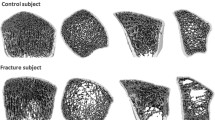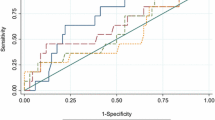Abstract:
To determine whether magnetic resonance (MR)-derived measures of trabecular bone architecture in the distal radius are predictive for prevalent hip fractures, 20 subjects with hip fractures and 19 age-matched postmenopausal controls were studied. Bone mineral density (BMD) measures at the hip (dual-energy X-ray absorptiometry, DXA) and the distal radius (peripheral quantitative computed tomography, pQCT) were also obtained. We compared the MR-based structural measures derived in the radius with those in the calcaneus of the same patients. In the radius, images were acquired at an in-plane resolution of 156 μm and a slice thickness of 0.5 mm. Stereologic measures such as the apparent trabecular thickness (app. Tb.Th), fractional trabecular bone volume (app. BV/TV), trabecular spacing (app. Tb.Sp) and trabecular number (app. Tb.N) were derived from the images. Measures of app. Tb.Sp and app. Tb.N in the distal radius showed significant (p<0.05) differences between the two groups, as did hip BMD measures. However, radial trabecular BMD measures showed only a marginal difference (p= 0.05). Receiver operating curve analysis was used to determine the diagnostic efficacy of BMD, structural measures and a combination of the two. The area under the curve (AUC) for total hip BMD was 0.73, and for radial trabecular BMD was 0.69. AUC for most of the measures of trabecular bone structure at the distal radius was lower than for hip BMD measures; however, AUC for app. Tb.N at the radius was 0.69, comparable to trabecular BMD using pQCT. The AUC for combined BMD (hip) and structure measures was higher (0.87) when radius and calcaneus structure was included. Measures of trabecular architecture derived from MR images combined with BMD measures improve the discrimination between subjects with hip fractures and normal age-matched controls.
Similar content being viewed by others
Author information
Authors and Affiliations
Additional information
Received: 22 December 1998 / Accepted: 12 February 1999
Rights and permissions
About this article
Cite this article
Majumdar, S., Link, T., Augat, P. et al. Trabecular Bone Architecture in the Distal Radius Using Magnetic Resonance Imaging in Subjects with Fractures of the Proximal Femur . Osteoporos Int 10, 231–239 (1999). https://doi.org/10.1007/s001980050221
Issue Date:
DOI: https://doi.org/10.1007/s001980050221




